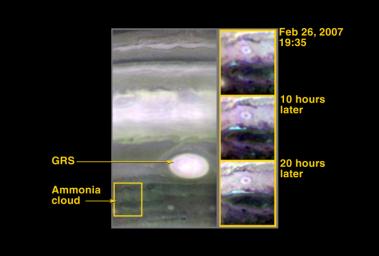
|
Probing Storm Activity on Jupiter
- Click the image above for a larger view
- Full-Res JPEG (3000 x 2025) (257.9 kB)
- Full-Res TIFF (3000 x 2025) (18.2 MB)
Caption:
Scientists assume Jupiter's clouds are composed primarily of ammonia, but only about 1% of the cloud area displays the characteristic spectral fingerprint of ammonia. This composite of infrared images taken by the New Horizons Linear Etalon Infrared Spectral Imager (LEISA) captures several eruptions of this relatively rare breed of ammonia cloud and follows the evolution of the clouds over two Jovian days. (One day on Jupiter is approximately 10 hours, which is how long it takes Jupiter to make one complete rotation about its axis.)
The New Horizons spacecraft was still closing in on the giant planet when it made these observations: Jupiter was 3.4 million kilometers (2.1 million miles) from the New Horizons spacecraft for the LEISA image taken at 19:35 Universal Time on February 26, 2007, and the distance decreased to 2.5 million kilometers (1.6 million miles) for the last image shown. LEISA's spatial resolution scale varied from approximately 210 kilometers (130 miles) for the first image to 160 kilometers (100 miles) for the last one.
New Horizons scientists originally targeted the region slightly northwest (up and to the left) of the Great Red Spot to search for these special ammonia clouds because that's where they were most easily seen during infrared spectral observations made by the Galileo spacecraft. But unlike the churning, turbulent cloud structures seen near the Great Red Spot during the Galileo era, this region has been quieting down during the past several months and was unusually tranquil when New Horizons passed by. Nevertheless, LEISA managed to find other regions of fresh, upwelling ammonia clouds, and the temporal evolution of one such region is displayed in this figure. In the first image, a fresh ammonia cloud (the blue region) sprouts from between white clouds and a dark elongated region. This blue cloud subsequently stretches along the white-dark border in the next two images.
These fresh ammonia clouds trace the strong upwelling of gases from the largely hidden depths of Jupiter to higher altitudes. Presumably, water is also being dragged up from below, and the subsequent condensation of that water, which is far more abundant than ammonia in Jupiter's atmosphere, into cloud droplets energizes the lower troposphere.
LEISA produces images at infrared wavelengths, which is heat radiation that cannot be sensed by the human eye. These "false color" images were produced by putting images of Jupiter at wavelengths of 1.99 micrometers, 1.94 micrometers and 2.04 micrometers into the red, green and blue channels, respectively, of the image display. Ammonia has an absorption feature at 1.99 microns, and when the colors are combined in this way the fresh ammonia clouds take on a bluish hue.
Cataloging Keywords:
| Name | Value | Additional Values |
|---|---|---|
| Target | Jupiter | |
| System | Jupiter | |
| Target Type | Planet | |
| Mission | New Horizons | Galileo |
| Instrument Host | New Horizons | Galileo Orbiter |
| Host Type | Flyby Spacecraft | Orbiter |
| Instrument | Linear Etalon Imaging Spectral Array (LEISA) | |
| Detector | ||
| Extra Keywords | Ammonia, Atmosphere, Color, Infrared, Rotation, Storm, Water | |
| Acquisition Date | ||
| Release Date | 2007-05-01 | |
| Date in Caption | 2007-02-26 | |
| Image Credit | NASA/Johns Hopkins University Applied Physics Laboratory/Southwest Research Institute | |
| Source | photojournal.jpl.nasa.gov/catalog/PIA09340 | |
| Identifier | PIA09340 | |
